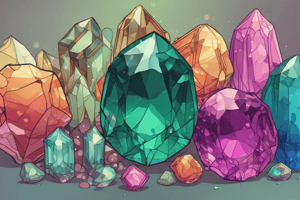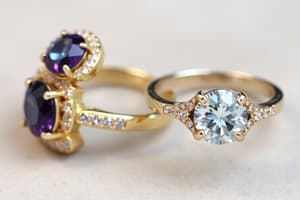Podcast
Questions and Answers
Which gemstone shapes are ideally suited for prong settings?
Which gemstone shapes are ideally suited for prong settings?
- Round, square, and marquise (correct)
- Oval and pear-shaped only
- Only large gemstones with high quality
- Bezel and tension shaped only
What factors should influence the choice of gemstone setting?
What factors should influence the choice of gemstone setting?
- Personal history with gemstones
- Only the aesthetic preference of the jeweler
- Gemstone color only
- Stone cut, size, metal type, aesthetics, and wear (correct)
Which setting type is most likely to support larger and more delicate stones?
Which setting type is most likely to support larger and more delicate stones?
- Prong setting
- Tension or bezel setting (correct)
- Pavé setting
- Channel setting
What is an advantage of using a bezel setting for gemstones?
What is an advantage of using a bezel setting for gemstones?
Which of the following statements regarding metals used in gemstone settings is accurate?
Which of the following statements regarding metals used in gemstone settings is accurate?
What is a potential drawback of a prong setting compared to a bezel setting?
What is a potential drawback of a prong setting compared to a bezel setting?
Which setting type is most likely to provide a highly reflective appearance?
Which setting type is most likely to provide a highly reflective appearance?
In what way is an invisible setting particularly advantageous?
In what way is an invisible setting particularly advantageous?
What distinguishes a channel setting from a pavé setting?
What distinguishes a channel setting from a pavé setting?
What is a disadvantage of a tension setting?
What is a disadvantage of a tension setting?
Which statement about girdle settings is true?
Which statement about girdle settings is true?
What characteristic is common to both claw and prong settings?
What characteristic is common to both claw and prong settings?
Which gemstone setting type can potentially conceal some of the detail of a facet-cut stone?
Which gemstone setting type can potentially conceal some of the detail of a facet-cut stone?
Flashcards
Prong Setting
Prong Setting
A setting using metal prongs to grip a gemstone.
Bezel Setting
Bezel Setting
A setting where the gemstone is enclosed by a metal band.
Channel Setting
Channel Setting
A setting using a groove to hold multiple gemstones.
Tension Setting
Tension Setting
Signup and view all the flashcards
Pavé Setting
Pavé Setting
Signup and view all the flashcards
Girdle Setting
Girdle Setting
Signup and view all the flashcards
Invisible Setting
Invisible Setting
Signup and view all the flashcards
Claw Setting
Claw Setting
Signup and view all the flashcards
Gemstone Setting Choice Factors
Gemstone Setting Choice Factors
Signup and view all the flashcards
Pave/Channel Setting
Pave/Channel Setting
Signup and view all the flashcards
Bezel Setting
Bezel Setting
Signup and view all the flashcards
Prong Setting
Prong Setting
Signup and view all the flashcards
Metal Type in Settings
Metal Type in Settings
Signup and view all the flashcards
Study Notes
Introduction to Gemstone Setting Types
- Gemstone settings are the mountings or mount that holds the gemstone in place.
- They play a crucial role in securing the stone, showcasing its beauty, and providing structural support.
- Different setting types offer varying aesthetics, durability, and price points.
- Functionality and style influence the selection of a particular setting.
Common Setting Types
- Prong Setting:
- Consists of several metal "prongs" that grip the gemstone.
- Provides excellent visibility of the gemstone.
- Relatively secure, especially with well-crafted prongs.
- Can be delicate if not properly executed.
- Common for solitaire and multiple stones.
- Bezel Setting:
- The gemstone is completely enclosed by a metal band (bezel).
- Offers excellent security and protection for the gemstone.
- Minimalist and often used for cabochon-cut stones.
- Conceals the edges of the gemstone.
- May hide some of the detail of a facet-cut gemstone making it appear less sparkly.
- Channel Setting:
- A continuous groove or channel holds multiple gemstones in line, typically along a band or bezel.
- Enables a smooth and continuous look.
- Typically used with smaller gemstones and provides a secure setting.
- Suitable for creating a 'pavé' or 'milgrain' effect.
- Tension Setting:
- The gemstone is held in place by tension or pressure from the metal mounting.
- Minimal metal shows, creating a dramatic effect.
- Prone to damage if the tension is improperly applied or the stone is too large.
- Often used for aesthetically pleasing, albeit less secure settings for smaller stones.
- Pavé Setting:
- Multiple small gemstones are set closely together, often in a tightly packed pattern.
- Creates a highly reflective and dazzling appearance.
- Requires meticulous craftsmanship.
- Often used for rings, necklaces, and earrings.
- Girdle Setting:
- A setting that secures gemstones by clamping down on the girdle (the narrowest part) of the stone.
- Usually employed with cabochon-cut stones.
- Enhances the dimensional aspect of the stone.
- Requires precision and may be less durable than other settings.
- Invisible Setting:
- The gemstone is practically flush with the metal setting.
- Provides a modern and delicate look.
- Highly secure.
- Often used with small and valuable gemstones.
- Claw Setting:
- Similar to prongs but with a more rounded or curved grip that encases the sides and top.
- Provides excellent security.
- A variation on the prong setting.
- Shows the full profile and facets of the stone.
Factors Influencing Gemstone Setting Choice
- Stone Cut and Shape:
- Oval and pear-shaped gemstones often benefit from bezel settings.
- Round, square, marquise, and pear-shaped stones are well-suited to prong settings.
- Gemstone Size and Quality:
- Smaller stones often work well in pavé or channel settings.
- Larger and more delicate stones may require a bezel or tension setting that allows for support.
- Metal Type and Color:
- Different metals, like platinum, gold, and silver, have distinct aesthetics influencing the selected setting.
- The color of the metal can complement or contrast with the gemstone.
- Desired Aesthetics:
- The style of the setting affects the overall look of the jewelry piece.
- The setting should match the intended design and wearer.
- Budgetary Constraints:
- Setting types can vary significantly in labor costs and materials involved.
- The choice of setting type can affect the overall cost of the piece.
- Durability and Wear:
- A setting should consider the amount of wear and tear the jewelry will encounter.
- More active wearers might prefer more secure settings like bezels to prevent gemstones from falling out.
- Prongs are less secure and prone to moving stones.
Materials Used in Gemstone Settings
- Metals such as platinum, yellow gold, white gold, rose gold, or sterling silver
- Often mixed metals due to price considerations or aesthetic preferences
- Materials such as diamonds or other jewels can be included as accents.
Studying That Suits You
Use AI to generate personalized quizzes and flashcards to suit your learning preferences.




